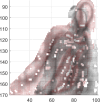An automatic tracking method to measure the mandibula movement during real time MRI
- PMID: 39406788
- PMCID: PMC11480379
- DOI: 10.1038/s41598-024-74285-9
An automatic tracking method to measure the mandibula movement during real time MRI
Abstract
Mandibular movement is complex and individual due to variations in the temporomandibular joint (TMJ). Consequently, patient-centered dentistry should incorporate patients' specific anatomy and condylar function in treatment planning. Real-time magnetic resonance imaging (rt-MRI) visualizes relevant structures and tracks mandibular movement. However, current assessments rely on qualitative observations or time-consuming manual tracking, lacking reliability. This study developed an automatic tracking algorithm for mandibular movement in rt-MRI using least mean square registration (LMS) and compared it to manual tracking (MT) during mouth opening. Ten participants with skeletal class I underwent rt-MRI (10 frames/s). The same operator tracked the condylar pathway for the two methods, setting 2000 landmarks (2 landmarks x100 frames x10 participants) for MT and 210 landmarks (3 landmarks x7 frames x10 participants) for LMS. Time required, superimposition error, and the distance between tracked condylar pathways were compared between methods. LMS tracking was 76% faster and showed significantly better superimposition (0.0289 ± 0.0058) than MT (0.059 ± 0.0145) (p = 0.002). During one-third of the movement, the pathways tracked by both methods were more than 1 mm and 1° apart. These findings highlight the benefits of automatic condylar movement tracking in rt-MRI, laying the groundwork for more objective and quantitative observation of TMJ function.
Keywords: Condyle; LMS algorithm; Temporomandibular joint; Tracking; rtMRI.
© 2024. The Author(s).
Conflict of interest statement
The authors declare no competing interests.
Figures







References
-
- Shah, P. & Chong, B. S. 3D imaging, 3D printing and 3D virtual planning in endodontics. Clin. Oral Invest.22, 641–654 (2018). - PubMed
-
- Onoda, N., Mikami, T., Saito, N. & Kobayashi, T. Evaluation of oral health-related quality of life in patients with temporomandibular disorders. Cranio - J. Craniomandib.41, 486–493 (2023). - PubMed
MeSH terms
LinkOut - more resources
Full Text Sources
Medical

